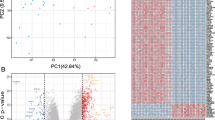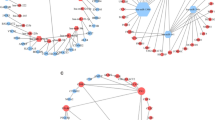Abstract
Hepatocyte nuclear factor-1β (Hnf1β) is associated with early embryogenesis failure, renal cysts, and/or diabetes. However, factors regulating Hnf1β expression in metanephric mesenchyme cells remain poorly understood. Here, we analyzed the modulation relationship of Hnf1β and miR-194 in mouse metanephric mesenchyme (MM) cells. Bioinformatics analysis, luciferase assay and semi-quantitative real-time (qPCR), western blotting, 5-ethynyl-2′-deoxyuridine cell proliferation assay, wound healing assay, and flow cytometry were employed to detect the function of miR-194 by targeting on Hnf1β in mouse MM cells. Bioinformatic prediction revealed one conserved binding site (CAGTATT) of miR-194 on Hnf1β 3’-UTR and luciferase reporter assay suggested that this is an effective target site of miR-194, and mutating CAGTATT with CGTACTT had no effects on luciferase activity compared with control. Overexpression of miR-194 decreased Hnf1β mRNA and protein level in mouse MM cells. In addition, miR-194-decreased cell proliferation and miR-194-promoted cell apoptosis and migration were reversed by overexpression of Hnf1β coding region. In addition, Hnf1β-upregulated genes were decreased in miR-194 overexpression cells and rescued in miR-194 and Hnf1β CDS region co-overexpression cells. Our findings explored one new regulator of Hnf1β and revealed the function of their regulation in cell proliferation, migration, and apoptosis in mouse metanephric mesenchyme cells. For strict regulation of Hnf1β in kidney development, these findings provide theoretical guidance for kidney development study and kidney disease therapy.





Similar content being viewed by others
References
Ambros V (2004) The functions of animal microRNAs. Nature 431:350–355
Bai XY, Ma Y, Ding R, Fu B, Shi S, Chen XM (2011) miR-335 and miR-34a promote renal senescence by suppressing mitochondrial antioxidative enzymes. J Am Soc Nephrol 22:1252–1261
Bao C, Li Y, Huan L, Zhang Y, Zhao F, Wang Q, Liang L, Ding J, Liu L, Chen T, Li J, Yao M, Huang S, He X (2015) NF-kappaB signaling relieves negative regulation by miR-194 in hepatocellular carcinoma by suppressing the transcription factor HNF-1alpha. Sci Signal 8:ra75
Chan SC, Zhang Y, Shao A, Avdulov S, Herrera J, Aboudehen K, Pontoglio M, Igarashi P (2018) Mechanism of fibrosis in HNF1B-related autosomal dominant tubulointerstitial kidney disease. J Am Soc Nephrol 29:2493–2509
Clissold RL, Hamilton AJ, Hattersley AT, Ellard S, Bingham C (2015) HNF1B-associated renal and extra-renal disease-an expanding clinical spectrum. Nat Rev Nephrol 11:102–112
Coffinier C, Barra J, Babinet C, Yaniv M (1999) Expression of the vHNF1/HNF1beta homeoprotein gene during mouse organogenesis. Mech Dev 89:211–213
Desgrange A, Heliot C, Skovorodkin I, Akram SU, Heikkila J, Ronkainen VP, Miinalainen I, Vainio SJ, Cereghini S (2017) HNF1B controls epithelial organization and cell polarity during ureteric bud branching and collecting duct morphogenesis. Development (Cambridge, England) 144:4704–4719
Dressler GR (2006) The cellular basis of kidney development. Annu Rev Cell Dev Biol 22:509–529
Dudziak K, Mottalebi N, Senkel S, Edghill EL, Rosengarten S, Roose M, Bingham C, Ellard S, Ryffel GU (2008) Transcription factor HNF1beta and novel partners affect nephrogenesis. Kidney Int 74:210–217
Ferre S, Igarashi P (2018) New insights into the role of HNF-1beta in kidney (patho)physiology. Pediatric nephrology (Berlin, Germany). https://doi.org/10.1007/s00467-018-3990-7
Goda N, Murase H, Kasezawa N, Goda T, Yamakawa-Kobayashi K (2015) Polymorphism in microRNA-binding site in HNF1B influences the susceptibility of type 2 diabetes mellitus: a population based case-control study. BMC Med Genet 16:75
Hajarnis SS, Patel V, Aboudehen K, Attanasio M, Cobo-Stark P, Pontoglio M, Igarashi P (2015) Transcription factor hepatocyte nuclear factor-1beta (HNF-1beta) regulates microRNA-200 expression through a long noncoding RNA. J Biol Chem 290:24793–24805
Ho J, Kreidberg JA (2012) The long and short of microRNAs in the kidney. J Am Soc Nephrol 23:400–404
Kloosterman WP, Plasterk RH (2006) The diverse functions of microRNAs in animal development and disease. Dev Cell 11:441–450
Lindstrom NO, Lawrence ML, Burn SF, Johansson JA, Bakker ER, Ridgway RA, Chang CH, Karolak MJ, Oxburgh L, Headon DJ, Sansom OJ, Smits R, Davies JA, Hohenstein P (2015) Integrated beta-catenin, BMP, PTEN, and notch signalling patterns the nephron. Elife 4(3):e04000
Little MH, McMahon AP (2012) Mammalian kidney development: principles, progress, and projections. Cold Spring Harb Perspect Biol 4. https://doi.org/10.1101/cshperspect.a008300
Lokmane L, Heliot C, Garcia-Villalba P, Fabre M, Cereghini S (2010) vHNF1 functions in distinct regulatory circuits to control ureteric bud branching and early nephrogenesis. Development 137:347–357
Lv X, Mao Z, Lyu Z, Zhang P, Zhan A, Wang J, Yang H, Li M, Wang H, Wan Q, Wei H, Wang M, Wang N, Li X, Liu Y, Zhao H, Zhou Q (2014) miR181c promotes apoptosis and suppresses proliferation of metanephric mesenchyme cells by targeting Six2 in vitro. Cell Biochem Funct 32:571–579
lyu Z, Mao Z, Wang H, Fang Y, Chen T, Wan Q, Wang M, Wang N, Xiao J, Wei H, Li X, Liu Y, Zhou Q (2013) MiR-181b targets Six2 and inhibits the proliferation of metanephric mesenchymal cells in vitro. Biochem Biophys Res Commun 440:495–501
Massa F, Garbay S, Bouvier R, Sugitani Y, Noda T, Gubler MC, Heidet L, Pontoglio M, Fischer E (2013) Hepatocyte nuclear factor 1beta controls nephron tubular development. Development 140:886–896
Reidy KJ, Rosenblum ND (2009) Cell and molecular biology of kidney development. Semin Nephrol 29:321–337
Sun K, Lai EC (2013) Adult-specific functions of animal microRNAs. Nat Rev Genet 14:535–548
Sun Y, Koo S, White N, Peralta E, Esau C, Dean NM, Perera RJ (2004) Development of a micro-array to detect human and mouse microRNAs and characterization of expression in human organs. Nucleic Acids Res 32:e188
Takasato M, Little MH (2015) The origin of the mammalian kidney: implications for recreating the kidney in vitro. Development 142:1937–1947
Tang O, Chen XM, Shen S, Hahn M, Pollock CA (2013) MiRNA-200b represses transforming growth factor-beta1-induced EMT and fibronectin expression in kidney proximal tubular cells. Am J Physiol Renal Physiol 304:F1266–F1273
Wang F, Yao Y, Yang HX, Shi CY, Zhang XX, Xiao HJ, Zhang HW, Su BG, Zhang YQ, Guo JF, Ding J (2017) Clinical phenotypes of hepatocyte nuclear factor 1 homeobox b-associated disease. Zhonghua Er Ke Za Zhi 55:658–662
Xu J, Kang Y, Liao WM, Yu L (2012) MiR-194 regulates chondrogenic differentiation of human adipose-derived stem cells by targeting Sox5. PLoS One 7:e31861
Zhang J, Qu P, Zhou C, Liu X, Ma X, Wang M, Wang Y, Su J, Liu J, Zhang Y (2017) MicroRNA-125b is a key epigenetic regulatory factor that promotes nuclear transfer reprogramming. J Biol Chem 292:15916–15926
Zheng J, Liu X, Xue Y, Gong W, Ma J, Xi Z, Que Z, Liu Y (2017) TTBK2 circular RNA promotes glioma malignancy by regulating miR-217/HNF1beta/Derlin-1 pathway. J Hematol Oncol 10:52
Acknowledgements
Thanks to all the members in the M.O.E. Key Laboratory of Laboratory Medical Diagnostics, the College of Laboratory Medicine, and Chongqing Medical University.
Funding
This work is funded by the National Science Foundation for Young Scientists of China (Grant No. 31701218) and the Basic Science and Frontier Technology Research Program of Chongqing Science and Technology Commission (Grant No. cstc2017jcyjA0390) and by Yajun Xie Ph.D.
Author information
Authors and Affiliations
Contributions
Y.X. conceived and designed the study. Y.L. performed the experiments. Y.H., D.N., and J. L. contributed to materials and analysis tools. H. X. and L. X. provided reagents. Y. Liu and Y. X. wrote the manuscript with comments from all authors. Q. Z. provided conceptual advice.
Corresponding author
Ethics declarations
Conflict of interest
The authors declare that they have no conflicts of interest.
Additional information
Editor: Tetsuji Okamoto
Highlights
• miR-194 is a negative regulator of Hnf1β in mouse MM cells
• miR-194 directly targets on the 3’-UTR of Hnf1β
• Hnf1β coding region rescues the phenotypes caused by miR-194-overexpression
Electronic supplementary material
Supplementary Figure 1
miR-194 inhibited the NF-κB activity in mK3 cells. mK3 control cells and cells transfected with miR-194 or miR-194 combined with Hnf1β were detected with indicated antibodies by western blotting. (PDF 413 kb)
Supplementary Figure 2
miR-194-promoted cell apoptosis and delayed-cell cycle were partially rescued by Hnf1β coding region (A) Cell apoptosis of mK3 control cells and cells with expression of miR-194 or co-expression of miR-194 and Hnf1β were measured by flow cytometric analysis after FITC and PI staining. Q1, necrotic cells; Q2, late apoptotic cells; Q3, normal cells; Q4, early apoptotic cells. Q2 + Q4 cells were calculated as total apoptotic cells. (B) Quantitative analysis of flow cytometric analysis shown in (A). (C) Cell cycle distribution of mK3 control cells and cells with expression of miR-194 or co-expression of miR-194 and Hnf1β were measured by flow cytometric analysis. (D) Quantitative analysis of flow cytometric analysis shown in (C). Data were presented as mean ± SEM from three independent experiments. Statistical analysis was performed with Student’s t test. *p < 0.05. (PDF 549 kb)
Rights and permissions
About this article
Cite this article
Liu, Y., Hu, Y., Ni, D. et al. miR-194 regulates the proliferation and migration via targeting Hnf1β in mouse metanephric mesenchyme cells. In Vitro Cell.Dev.Biol.-Animal 55, 512–521 (2019). https://doi.org/10.1007/s11626-019-00366-z
Received:
Accepted:
Published:
Issue Date:
DOI: https://doi.org/10.1007/s11626-019-00366-z




